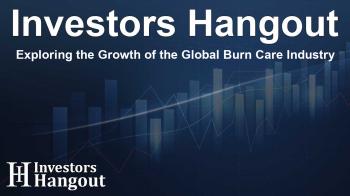Exploring the Growth of the Global Burn Care Industry

The Expansion of the Burn Care Market
The global Burn Care Market has witnessed remarkable growth, valued at approximately US$2.46 billion in recent evaluations. Forecasts indicate this figure is set to increase significantly, reaching an impressive US$3.35 billion by the end of the decade. This growth is primarily influenced by various factors contributing to the rising incidence of burn injuries. Industrial accidents, domestic fires, and increased awareness about proper burn care are pivotal in driving demand for effective treatment solutions.
Demographic Dynamics Fueling Demand
An essential aspect of the market's growth is the changing demographics, notably the aging global population. As people age, they frequently experience slower healing rates and a greater risk of complications following burns. Consequently, the demand for advanced burn care products is on the rise. Innovations in treatment technologies, such as smarter burn dressings and enhanced wound assessment devices, are enhancing the effectiveness of care provided for burn injuries.
Segment Analysis of Burn Care Products
When we dissect the burn care market, it is segmented into several categories including advanced burn dressings, burn wound therapy devices, biologics, traditional products, and others. Among these, the biologics segment is poised to see the highest growth rate in the coming years, fueled by an increasing demand for modern treatment options that cater specifically to deep and complex burns. Biologics not only expedite the healing process but also reduce the risk of long-term complications.
Understanding Burn Severity Categories
Burns are classified into different degrees: first-degree burns, second-degree burns, and third-degree burns. Notably, second-degree burns, classified as partial-thickness injuries, account for a substantial share of the market. This prevalence stems from the nature of these injuries, which can often be more severe and require ongoing advanced treatment, thereby driving the demand for specialized burn care products.
Regional Insights into the Burn Care Market
Geographically, the burn care market is segmented into major regions including North America, Europe, Asia Pacific, Latin America, and the Middle East & Africa. North America holds a leading position in this market, marked by its sophisticated healthcare infrastructure and a high incidence rate of burn injuries. The presence of established players and a strong focus on research and development have further solidified North America's dominance in burn care.
Key Players in the Market
The landscape of the burn care market includes several notable players such as Smith+Nephew from the UK, Mölnlycke Health Care AB from Sweden, and Cardinal Health Inc. from the US, among others. These companies have invested heavily in research and product development to provide effective burn care solutions. For example, Smith+Nephew has been recognized for its innovative wound care products that cater specifically to severe burn cases.
Technological Advancements Shaping the Future
Continuous technological advancements play a crucial role in shaping the future landscape of the burn care market. With a focus on regenerative medicine and innovative treatment modalities, companies are consistently seeking to enhance patient outcomes. For instance, the recent introduction of biologics in wound care illustrates a significant shift toward more effective treatments that facilitate faster healing.
Strategic Collaborations and Partnerships
Companies are increasingly engaging in strategic collaborations to improve their market position and expand their reach. Mölnlycke Health Care AB, for instance, has formed partnerships with various organizations to promote awareness and enhance the quality of burn care worldwide.
Conclusion: A Bright Outlook for Burn Care
The burn care market is on the brink of substantial growth driven by multiple factors that range from increasing population needs to technological innovations and strategic partnerships among key industry players. As the healthcare sector continues to evolve, there is no doubt that effective burn care will become even more crucial, creating opportunities for businesses to thrive in this dynamic environment.
Frequently Asked Questions
What is the projected size of the burn care market by 2030?
The burn care market is projected to reach US$3.35 billion by 2030.
What factors are driving the growth of the burn care market?
The rise in burn injuries, advancements in treatment technologies, and increased awareness about burn care significantly contribute to market growth.
Which segment is expected to grow the fastest in the burn care market?
The biologics segment is anticipated to register the highest growth rate due to the demand for effective treatment options for severe burns.
How are burn injuries categorized?
Burn injuries are classified into three main degrees: first-degree, second-degree, and third-degree burns, with second-degree burns accounting for a large market share.
Which regions lead in the burn care market?
North America leads the burn care market, owing to its advanced healthcare facilities and a high incidence of burn injuries.
About The Author
Contact Henry Turner privately here. Or send an email with ATTN: Henry Turner as the subject to contact@investorshangout.com.
About Investors Hangout
Investors Hangout is a leading online stock forum for financial discussion and learning, offering a wide range of free tools and resources. It draws in traders of all levels, who exchange market knowledge, investigate trading tactics, and keep an eye on industry developments in real time. Featuring financial articles, stock message boards, quotes, charts, company profiles, and live news updates. Through cooperative learning and a wealth of informational resources, it helps users from novices creating their first portfolios to experts honing their techniques. Join Investors Hangout today: https://investorshangout.com/
The content of this article is based on factual, publicly available information and does not represent legal, financial, or investment advice. Investors Hangout does not offer financial advice, and the author is not a licensed financial advisor. Consult a qualified advisor before making any financial or investment decisions based on this article. This article should not be considered advice to purchase, sell, or hold any securities or other investments. If any of the material provided here is inaccurate, please contact us for corrections.

